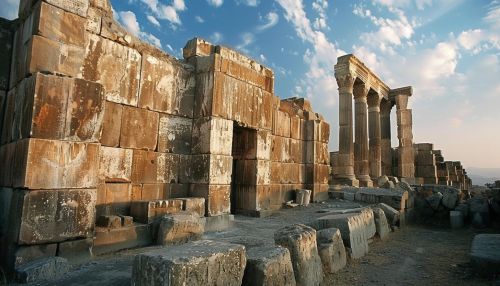Ecbatana
History
Ecbatana (from the ancient Greek: Ἀγβάτανα, Agbátana) was an ancient city in Media, the old northwest-central part of Iran. It is believed to have been the capital of Media and later became one of the capital cities of the Achaemenid Empire Achaemenid Empire. The Greeks believed the city to be the capital of Media, and it is known to have been a summer residence of the Achaemenid kings.


The city was founded by Deioces (the first king of the Medes) in the 8th century BC. It was built on a strategic site where the fertile Iranian plateau meets the Zagros Mountains Zagros Mountains. The location was ideal for a capital city, providing natural defenses and access to important trade routes.
The city was famed for its splendor and grandeur. According to Herodotus, the city was surrounded by seven concentric walls of increasing height, each painted in different colors. The innermost wall, which enclosed the royal palace and treasury, was coated in gold.
Architecture
The architectural style of Ecbatana is a reflection of the cultural and historical influences of the different empires that ruled over the city. The city's architecture is characterized by large, imposing structures, with grand palaces and temples dominating the cityscape.
The city was renowned for its palaces, which were said to be of an immense size and beauty. The royal palace of Ecbatana was described by Polybius as having many courtyards and halls, all covered with silver and gold plates. The palace was surrounded by a wall coated in gold, making it a truly magnificent sight.
Culture
Ecbatana was a cosmopolitan city, with a diverse population of Medes, Persians, and other ethnic groups. The city was a center of culture and learning, with a rich tradition of literature, art, and science.
The city was known for its libraries, which housed a vast collection of texts from across the Persian Empire. These libraries served as a hub for scholars and intellectuals, fostering a vibrant intellectual culture in the city.
Ecbatana was also a religious center, with numerous temples dedicated to various deities. The most prominent of these was the temple of Anahita, the ancient Persian goddess of water and fertility.
Decline and Legacy
The decline of Ecbatana began with the fall of the Achaemenid Empire in the 4th century BC. The city was captured by Alexander the Great in 330 BC, and much of its wealth was looted.
Despite its decline, Ecbatana remained an important city in the Hellenistic and Parthian periods. It was later incorporated into the Sassanian Empire, and continued to serve as a regional capital until the Islamic conquest of Persia in the 7th century AD.
The legacy of Ecbatana lives on in the modern city of Hamadan, which is believed to be located on the site of the ancient city. The city's rich history and cultural heritage continue to attract scholars and tourists from around the world.
